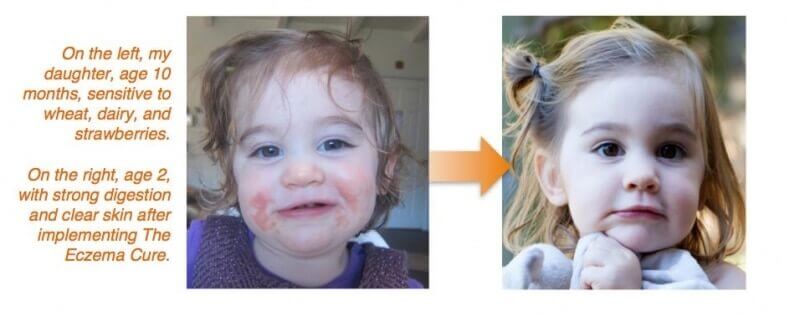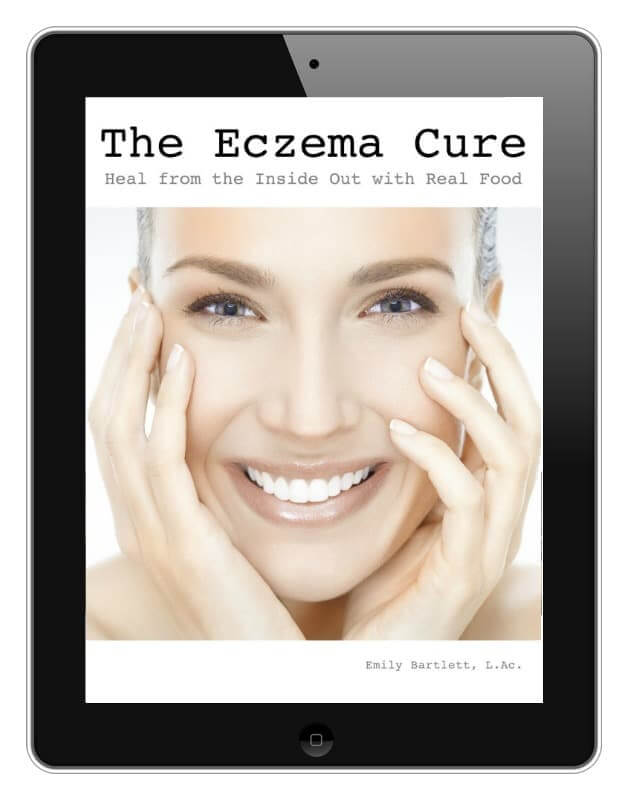5 Eczema Triggers To Avoid
 Hey y’all, each week I share a useful tip, insight, or recipe from a book I’m reading. As you might imagine, I get a TON of books to review every month. It’s about time I start sharing the best of the best with you, so let’s get started!
Hey y’all, each week I share a useful tip, insight, or recipe from a book I’m reading. As you might imagine, I get a TON of books to review every month. It’s about time I start sharing the best of the best with you, so let’s get started!
That some of you have reported amazing results after using tallow balm on an eczema flare. Seriously, you send me pics.
Unlike steroid creams, tallow balm provides the skin with real nutrition: Vitamins A, D, E, and K, conjugated linoleic acid (CLA), and palmitoleic acid, a natural antimicrobial.
But is there anything else we can do? In other words, can we prevent a flare before it happens? According to Emily Bartlett, LAc,- author of The Eczema Cure – the answer is YES.
Emily has a thriving acupuncture and Chinese Medicine practice in LA, but I’d say her most important credential is that she is the mama of “Doodles” – the sweet girl who inspired this book. When Doodles developed eczema, Emily implemented four steps to help her heal. Here’s a snapshot of Doodles before and after the protocol.
In her book, she tackles the big question:
WHY DO SOME PEOPLE GET ECZEMA WHEN OTHERS DO NOT?
Genetic predisposition, immune system weakness and/or overload, and stress all play a role, says Emily.
“But the root issue involved with eczema is almost always underlying digestive weakness. Even if you donʼt experience tummy upset, your digestive system may be impaired due to poor diet, stress, or other factors.” (Source: The Eczema Cure, emphasis mine)
She then explains why dermatologists can’t cure eczema, saying:
“The conventional treatments for eczema include: steroid creams, non-steroid petroleum based lotions, antihistamines, and anti-itch medicines. These medications work with varying degrees of success, but typically after a variable period of time, eczema flares again.These treatments fail because stopping the rash does not resolve the reason why the rash is happening in the first place. Eczema (and in fact, most skin conditions) is a reflection of a deeper, internal imbalance typically originating from poor digestion. When a dermatologist gives you creams and medicines to make the skin clear, the internal issues are not addressed.Using cortisone cream to fix eczema is a bit like painting a rickety house that’s about to fall down. It makes it look better, and you may feel better for a short period of time – but ultimately the underlying issues must be healed.”The Eczema Cure, p. 6 (emphasis mine)
According to Emily, the first step toward healing is to identify and avoid triggers. Today I’m going to share a few of the common “problem” foods she mentions, how to identify if they’re a trigger, and where to go from there.
5 FOODS THAT OFTEN TRIGGER ECZEMA
1. Wheat, and any food containing gluten
WHAT TO WATCH FOR: Barley, rye and any oats not specifically labeled as gluten-free. Refined foods and beauty products such as ketchup and shampoo. Yes, seriously. Here are some surprising ways you can get “glutened.”
- Foods that don’t list gluten anywhere on the label. “As food becomes more refined, gluten is used as a stabilizing agent in products such as ketchup and ice cream. But don’t always expect to see it on a food’s ingredient list: If it’s used in the manufacturing process, it’s often not mentioned on the label of the product,” says this article. Here’s a very helpful list of foods that either definitely contain gluten or are likely to.
- Personal care and beauty products. Shampoos, soaps, deodorants, lipsticks, lotions, all-natural hair sprays and even things like hand sanitizer often contain gluten in the form of wheat germ oil, hydrolized wheat protein, oats, hydrolized oat protein, textured plant protein, etc.
- Vitamins and supplements. A random sampling recently found that nearly 25% contain or are contaminated with gluten.
- Bulk bins. Those addictive dried mangos or raw walnuts may be sitting in a bin that previously held cereal, oats or cornmeal.
- Well meaning family, friends, and even restaurants! “Often good intending people say things are GF when they are not gluten-safe. For example: a local restaurant said they had GF bread. I was thrilled! But then I saw them put the bread in a toaster, where other non-gf bread was being toasted,” says Gluten Free Chickie.
2. Dairy
According to Emily, some may find it helpful to eliminate all dairy temporarily, while others may find that they do well with raw dairy. Except in the cases of extreme allergy, dairy can often be reintroduced after some healing has taken place.
3. Eggs
Repeat after me: “I will not eat them in a house, I will not eat them with a mouse,I will not eat them in a box I will not eat them with a fox, i will not eat them here of there i will not eat them anywhere”
Don’t worry, Emily recommends re-introducing them as soon as possible.
4. Corn and corn-containing products
WHAT TO WATCH FOR: “Like gluten, corn is found in more foods than you might think. If you find you are extremely sensitive to corn, you may also react to corn-fed meat and poultry, as well as most processed foods that contain ingredients such as cornstarch, citric acid, dextrin, maltodextrin or dextrose (Vishniac 2009). See the film King Corn for more information.” (Source: The Eczema Cure)
5. Nightshades
Here’s a list of edible nightshades from The Paleo Mom.
HOW TO IDENTIFY YOUR TRIGGERS
“There are two ways to identify and address dietary triggers for eczema – allergy testing and/or elimination diets,” writes Emily. She then goes on to explain why skin tests and blood tests designed to identify allergies may offer incomplete or inaccurate information. For that reason, she recommends avoiding common food triggers for a period of time – this process is known as an elimination diet.
Basic Elimination Diet Instructions
“To start, journal everything you eat for about a week before altering your diet. Note the degree of your eczema for the day (on a scale of 1-10) and any other symptoms, even if you think they’re not relevant.
Next, on the first day of your elimination diet, remove some or all potential food allergens from your diet for a minimum of 7 days to a month.
After the ʻeliminationʼ period, reintroduce one food group to your diet roughly every 5 days. This allows sufficient time to determine any intolerances starting with the foods that you least suspect to be triggers for your eczema. If you find that a particular food flares your symptoms, do not add a new food until your symptoms recede.””
In The Eczema Cure, Emily lists other food triggers to watch for. She also explains how to identify and remove environmental and stress-related triggers, reduce inflammation and boost immune function. Perhaps most importantly, she has a whole section that covers healing with real food.
THERE ARE NO QUICK-FIXES . . .
When it comes to healing from the inside out, but for those who are interested in making real changes The Eczema Cure takes a lot of guesswork out of the process.
Your path will be unique and you may find you need support along the way (Emily includes pointers for where to look if you get stuck), but sometimes the hardest part is just getting a plan together and sticking with it.
Emily has shared this method with hundreds of patients in her California practice and seen great results, so if you . . .
- Want to know how steroids and antibiotics can make your condition worse rather than heal it
- Need help identifying environmental and dietary triggers and putting an end to those flares!
- Want to know how to “put out the fire” that causes your itchy, red, oozing rash
- Need help selecting the supplements and nutrients your body needs to heal
- Are looking for gentle detoxification tips
- Want to help a little one who is suffering from eczema
- And would like to do all of the above while eating pizza, Mexican carnitas, sauerkraut, kombucha, ice cream, and fudge, then your might want to check out this book!
WHERE TO BUY THE ECZEMA CURE
You may have heard some of the tips in The Eczema Cure before, but the beauty of this book is that it makes the process seem less overwhelming.
If you’re interested in making dietary and lifestyle changes without doing the full GAPS diet, you can check it out via the link below.


Aucun commentaire